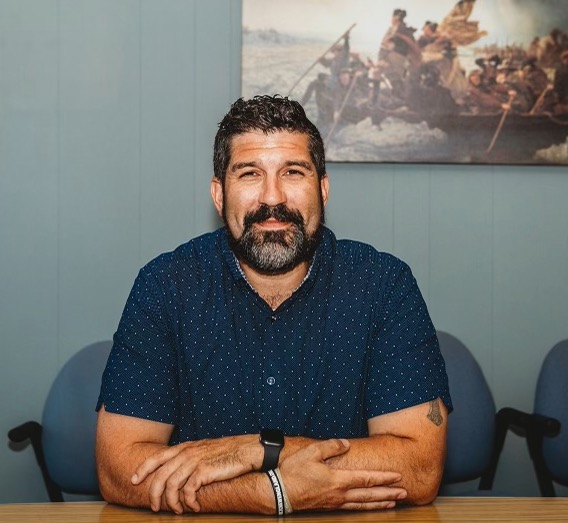
There Is A Solution
By Kerry J. Bickford, VOICES Editor
The world of recovery is filled with stories of success and failure, life vs. death. Many people often refer to their “rock bottom” when recalling the final straw that prevented them from becoming one more statistic. Although not everyone recognizes it, it’s crystal clear to others.
Nate Costa is one who remembers his rock bottom clearly. On January 1, 2011, he was living in his parents' basement with no job, no car, and no license, and he had gone on a bender the night before that had resulted in him waking up in a hospital after “getting his ass kicked.” He recalls feeling ashamed and not wanting his daughter (who was visiting) to see the shape her “hero” father was in. His father had just threatened him with eviction if he didn’t do something differently. That was when he made the decision to attend an AA meeting. Says Nate, “By God’s grace, I connected with a longtime neighbor at that meeting who had 26 years clean and sober. I had no idea he was in recovery. We began to talk, and he eventually became my sponsor.” Five years later, Nate opened his first 12-Step sober home, aptly naming it “There Is A Solution” (TIAS) because in his case, there was and he wanted to help others find theirs.
Nate remembers being an anxious child with big feelings when he began using alcohol at age 12 to wash it all away. He continued drinking and smoking weed as “a raging teenager,” but Nate managed to hold it together in grades 8 and 9 when, as an all-star athlete, he earned a gold medal in the Bay State games. By tenth grade, he failed off all athletic teams, got into fights, and continued to use. He went into rehab, was recruited to play lacrosse by an elite private school, where he was kicked out three quarters of the way into his junior year for drinking and fighting. He describes these years as peaks and valleys, talking about how difficult it was to maintain the peaks, as he began to recognize the “wolf that lived inside him.”
“There’s a good wolf and a bad wolf -- depending on which one you feed,” says Nate.
His life continued in that pattern, as he earned his diploma at night school and took a year off before attending two junior colleges and winning a national championship with his lacrosse team -- before crashing into another valley. He was charged with his first DUI at age 21, then another at 25. He eventually found himself living in his father’s basement, alone in the darkness, describing the alienation that takes place when addiction pushes people away, “No one wanted to be near me,” he said.
When Nate finally turned to AA and the “big book” for help, it changed his life. The 12 steps led him to his higher power, which, in turn, led him to a new purpose: helping others who suffer from a similar “spiritual malady.” He was committed to paying it forward as others did for him. So five years later, he went on a mission to reduce homelessness and to prevent people in recovery from “dying alone,” which is a very real thing that most people don’t even think about or recognize. It is nearly impossible for someone with a history of addiction to find a job, housing, new friends or a community in general. Nate describes slowly moving toward the light and wanting to help others do the same. AA opened the doors to a community of compassion, companionship, and healing, and he, in turn, opened the door to a safe recovery home.
Still, there have been casualties along the way. Even when it seems as if people are recovering, there is a very real thing in substance use disorder called relapse. A week or so before Overdose Awareness Day this year, Nate’s sober house team suffered a tragic loss that shook them to the core. Scott Banks, a TIAS resident died of an overdose after being sent into detox for using. “The whole house felt it,” said Nate, describing how Scott had made so much progress just a month before his death. They decided to have shirts made for the upcoming overdose awareness walk, and although Scott’s name was on the back of that shirt, it was symbolic for many other losses and provided a way for them all to come together and grieve, which has become somewhat of an occupational hazard when working in the recovery field.
Nate talks about how he and his team have been inspired, encouraged, and guided by something that each one of these lives taught them, despite the tragic way they ended. There is a kind of gift that remains after death that lies in what we choose to remember about what they taught us in their time on earth. Sometimes we share these gifts in stories, and other times they push us toward a better understanding of the way we think about substance use disorder -- or even toward new legislation. In sober living, it might provide insight to help others not give up when the going gets tough. The names and faces are etched into the landscape of those who continue the journey, drawing from that “well of inspiration.” Although we might not recognize this as grief, it is absolutely how many people, including Nate and his staff, cope with loss and continue on with their ministry.
Nate recognizes the critical importance of focusing on himself first and has developed a routine of rising early, praying, meditating, and working out before turning his attention to the needs of others. He knows he still has his own work to do and is generous in his heartfelt praise of staff, family, and others who continue to stick it out with him. He proudly displays a tattoo on one calf that says FALL 7 and on the other that says RISE 8, a reminder to never give up; there is a greater vision ahead. It might not be simple, but somewhere, somehow, there is always a solution.
